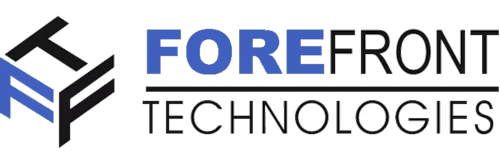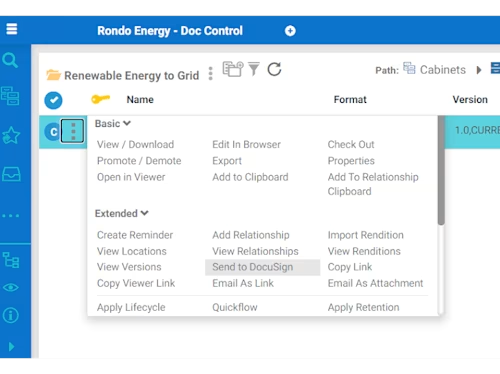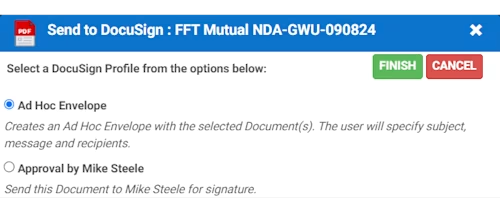
At the Forefront of Innovation: Leading the Way with Streamlined Document Solutions
See how Forefront Technologies, a leading document management systems consultancy, built a custom connector between Docusign and Documentum to bring electronic signatures into their document management solutions.


Forefront Technologies, a trusted partner of Docusign, is a consulting and integration firm that specializes in providing solutions for enterprise content management, records management, and case management. With expertise across various platforms, like OpenText, Appian, and Docusign, they offer a wide range of services that support clients in their digital transformation efforts. Their offerings include in-depth consulting services to assess document management needs, migration services to transition from legacy systems, and integration services to seamlessly connect platforms like Docusign and Documentum. By leveraging Docusign capabilities, Forefront Technologies helps clients achieve greater efficiency in their document and content management systems, ensuring that agreements are completed quickly and securely.
Forefront’s customers have expressed the need for a more streamlined, automated workflow that would significantly reduce the manual effort associated with document management. Even saving a few minutes per document translates into massive productivity gains for organizations dealing with thousands of documents. By automating the process of transferring signed documents from Docusign into Documentum, Forefront is providing clients with a much-needed return on investment. This automation doesn't just improve efficiency—it ensures that all documents and associated metadata are accurately stored in Documentum, maintaining compliance and reducing the risk of human error.
Forging Partnerships at the Forefront
Forefront Technologies leveraged the Docusign Documentum Connector as a comprehensive solution to integrate Docusign eSignature and Contract Lifecycle Management (CLM) capabilities with the robust content management features of OpenText Documentum. This integration provides businesses with a seamless system that supports the entire lifecycle of documents, from creation and signing to archival and management. As a records repository, Documentum ensures that all business-critical information is securely stored, organized, and compliant with industry regulations. At the same time, Docusign is used for fast, efficient electronic signatures, enabling organizations to handle everything from contracts to internal documents. This combination offers substantial improvements in workflow efficiency compared to traditional, manual methods of handling documents. In manual processes, tasks like transferring signed documents between systems, creating folders, or updating metadata often require human intervention. With the automation provided by Docusign-Documentum integration, these manual steps are eliminated, reducing the time spent on repetitive tasks and minimizing the risk of errors. Additionally, it provides real-time visibility into the status of agreements without the need for constant manual tracking or updates. The Docusign Documentum Connector enables Forefront to integrate the eSignature process directly into their content management systems, eliminating the need for disconnected workflows. It ensures that signed documents are automatically captured, stored, and managed in the Documentum repository, reducing risks of loss or non-compliance. This partnership helps businesses better manage their digital documents securely, efficiently, and cost-effectively, while also enhancing productivity through automated workflows and improved collaboration.
Building Momentum with Documentum
At the heart of Forefront Technologies' solutions, OpenText Documentum stands out as a proven and reliable platform, delivering exceptional value to customers. One of their key clients, for example, relies on both systems for managing critical documents. Traditionally, after completing the electronic signature process in Docusign, the client would manually input the signed documents into Documentum—an inefficient process involving the creation of folders and adding metadata. This manual task was not only time-consuming, but also prone to errors due to the sheer volume of documents they handle.
Figure 1 showcases the seamless integration enabled by the Docusign Documentum Connector. The Connector enables customers to connect both systems quickly, enabling smoother collaboration between document storage and eSignature workflows. Once installed within Documentum, the Connector streamlines the process of working across both platforms, enhancing operational efficiency and document management.
This integration is especially useful in industries such as energy and nuclear, where managing and storing documents securely is essential. Companies can use Documentum for storing critical records while leveraging Docusign for eSignature processes. The connector ensures that all signed documents are automatically transferred and stored in Documentum, simplifying both the approval and archiving processes.

Figure 1: A view of the connector which supports seamless integration between Docusign and Documentum.
The Engine of Innovation: Technical Insights on Forefront’s Integration
The integration between Docusign and Forefront Technologies is deeply rooted in a robust and flexible tech stack that facilitates both customization and scalability. At its core, the solution is built using Java, with the Docusign eSignature API forming the backbone of the document workflow automation. Forefront Technologies has created an encapsulation layer around the Docusign Java SDK, which abstracts the lower-level API calls, making it easier for their system to interact with Docusign without reconfiguring authentication and envelope creation code if any updates are needed.
This encapsulation layer manages key tasks such as JWT-based authentication, allowing the system to securely access Docusign without requiring individual users to log in each time. By using JWT, the system can operate on behalf of users, streamlining workflows across various departments. Documents prepared in Documentum are then sent to Docusign based on a configurable set of profiles. These profiles dictate how documents are routed, who needs to sign them, and when the process is complete. The XML configuration layer supports these profiles, enabling organizations to tailor workflows and business rules to their specific needs.
Additionally, the integration utilizes scheduled polling to check document status updates at regular intervals, typically every 60 minutes. This ensures synchronization between Docusign and Documentum without overwhelming the system with excessive calls. As mentioned earlier, the polling process is also controlled through the same series of configurable profiles, ensuring consistency while keeping the underlying code modular for future scaling and adjustments. We'll explore the rationale behind choosing polling over webhooks in the next section.
The flexibility of the Docusign Documentum Connector supports extensive customization. Clients are able to tailor workflows to their unique needs, ensuring that documents are automatically moved between systems once all signatures are completed. The integration even supports advanced configurations, such as custom scripts that control what happens to content after it has been signed. This level of automation and customization is particularly beneficial for clients who need to manage complex approval processes, routing documents to different stakeholders based on specific requirements. By eliminating manual workflows, Forefront Technologies is helping its clients unlock the full potential of both Docusign and Documentum, delivering faster and more secure document management processes.
Taking a Poll: A Balanced Alternative
Forefront Technologies opted for a polling approach over using the Docusign webhook product, Docusign Connect, largely due to the security needs of their clients in industries such as energy and government. Connect is a powerful, event-driven webhook service that automatically sends real-time notifications when an envelope's status changes, making it an efficient way to stay up-to-date with document activity. However, many organizations in these industries have stringent IT policies that prohibit exposing internal servers to the internet to receive external data, as would be required by a webhook. Polling avoids these issues by having the integration call Docusign for updates, therefore eliminating the need to expose the client’s server.
In the Docusign Documentum Connector, polling intervals are configurable: administrators are able to run updates more frequently if needed, ensuring that documents are always synced between Docusign and Documentum without overloading the system or hitting API limits. This approach involves the system periodically checking the status of envelopes in Docusign to determine when all signatures are completed. While webhooks operate in a more event-driven manner, sending notifications for a wide range of configurable events, polling offers greater flexibility in some scenarios by providing tighter control over the timing and behavior of the integration.
The Connector offers a configurable setup that enables clients to control how the integration behaves at the intersection of Docusign and Documentum. This includes custom options such as controlling the flow of documents and determining when a document is ready to be moved from Docusign to Documentum. The polling method supports these customizations by enabling clients to establish specific criteria for when and how documents should be transitioned between systems, ensuring greater control over document handling, especially in complex workflows. This method also supports extensive configuration, enabling users to define workflows that suit their unique business needs. For instance, the system can automatically update Documentum with new versions of signed documents or send notifications once all signatures are complete. By offering this level of control, Forefront ensures that clients have a tailored solution that can handle their document workflows with minimal manual intervention.
Signed, Sealed, Delivered: Ad Hoc Envelopes in Action
A key component of the integration is the ability for users to send documents on an ad hoc basis directly from Documentum to Docusign. With just a few clicks, users can choose recipients, assign signature fields, and manage document routes in real time. This level of customization makes the system extremely user-friendly while still catering to complex needs, such as managing signatures across multiple departments or for specific compliance requirements. This integration has already attracted interest from several Forefront customers who deal with high volumes of documentation, as it provides significant time savings and operational efficiencies. Forefront has received positive feedback about the improvements in automating what were previously manual, error-prone processes, particularly for clients working in highly regulated industries.
Figure 2 demonstrates the process of sending ad hoc documents from Documentum to Docusign using the connector. The process begins with a simple menu item within Documentum labeled "Send to Docusign." Selecting this option displays a modal dialog, as shown in Figure 3, where users can choose a Docusign Profile to use. The profiles listed are based on the user’s permissions for non–ad hoc profiles, as specified in each profile's configuration, and their inclusion in a designated group authorized to send ad hoc envelopes.
This ad hoc method is especially useful in industries such as federal agencies, where documents must be signed by designated teams—operations or engineering, for example. Users can include multiple recipients and customize the document by adding signature fields or date stamps. Once configured, the document is sent to Docusign for signatures, and the completed version is automatically archived in Documentum, ensuring a seamless workflow.

Figure 2: The user interface for automating document submission to Docusign.

Figure 3: Modal dialog for selecting a Docusign Profile, displaying available profiles based on user permissions and group membership for ad hoc envelope sending.
The Success of Forefront’s Docusign Integration
The integration of Docusign by Forefront Technologies has been a clear success, offering clients a more efficient, secure, and flexible approach to document management. By automating key processes such as eSignature collection and document storage, the solution has significantly reduced manual effort, increased productivity, and helped clients maintain compliance with regulatory requirements. This streamlined workflow has had a particularly positive impact on clients managing high volumes of critical documents, proving that the combination of Docusign capabilities and Forefront technical expertise can deliver powerful, tailored solutions. The connector has been generating significant interest and will be featured at OpenText World 2024 in mid-November, showcasing its growing prominence within the industry.
For businesses facing similar challenges with document workflows, whether dealing with operational inefficiencies or high document volumes, exploring Docusign eSignature and contract lifecycle management tools could be the answer. Docusign offers flexible, customizable solutions that can seamlessly integrate into your existing systems, as demonstrated by Forefront’s success. Reach out to learn how Docusign can help your organization automate, secure, and optimize your document processes, saving time and resources in the long run.

Niani Byrd joined the Docusign Developer Content team in 2024 as a Programmer Writer. With a background in software engineering and technical writing, she is passionate about helping developers discover and leverage the features of Docusign's APIs to build innovative solutions. Outside of work, she loves spending time with her dog, Niko.
Related posts
Docusign IAM is the agreement platform your business needs





